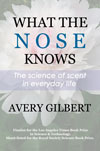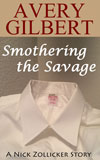
A book titled The Neuropsychology of Smell and Taste is not what one normally grabs from the shelf for amusement during a long plane ride. But having agreed to review it, I took it along on a recent flight from Newark to San Francisco figuring that it would, at least, deter annoying attempts at conversation from fellow passengers. How wrong I was. An attractive woman saw it peeking out of my carry-on bag and began talking to me in the boarding line; she is a neuropsychologist in the Bay Area. Somewhere over Nebraska the guy next to me asks me what I do; he has a cousin in the fragrance business he had to tell me about. Then the weirdo who had been marking up a briefcase full of fashion magazines chimed in about perfume trends; he’s a department store merchandiser. The lesson, I suppose, is that if you want to meet people you could do worse than get yourself a copy of Neil Martin’s new book.
Martin, who teaches psychology at Middlesex University in England, is the author of several well-regarded textbooks, as well as original research papers on, among other things, odor perception. His latest opus, part of the Psychology Press Brain, Behaviour and Cognition Series, is a lucid summary of the field aimed at advanced undergraduates, grad students, clinicians, and those looking to do research in the area—in other words, anyone with more than a casual interest in the functioning of the nose, tongue and brain. Those working in commercial venues—aromatherapists, neuromarketers, food writers, flavorists, ENTs, etc.—will also find it useful.
I think it says something positive about the field that there is finally a book to fill the gap between the hyper-focused experimental reports in the scientific literature and the dense, scholarly compilations that weigh down the bookshelves of the few with grant money enough to afford them. The area is sufficiently mature and the audience sufficiently wide to warrant an accessible treatment.
Martin’s topical approach is straightforward. He begins with the psychology of chemosensation and how smell and taste perceptions are measured. Then he reviews the major factors underlying individual differences: age, sex, personality, and culture. Next, he describes the basics of anatomy, neuroanatomy, and neurophysiology, covering everything from receptors to cortex and including such mechanical phenomena as the nasal cycle and swallowing. (Actually, he misses a couple of key papers debunking the nasal cycle by some fat-faced four-eyes but that’s a mere quibble in a work of this scope.) From there, it’s on to psychophysiology and neuro-imaging: the full array of studies using EEG, fMRI and allied techniques. The penultimate chapter deals with disorders of perception, including full attention to smell impairment in neurodegenerative diseases such as Parkinson’s and Alzheimer’s. He concludes with the neuropsychology of flavor, taking a wide view that includes interactions between smell, taste and sight, and the mechanisms of hunger and satiety.
Booyah! Martin’s coverage is exhaustive but not exhausting. He has a deft touch in highlighting key findings, and he leavens the text with witticisms as dry as the sherry in the faculty lounge. His judgment is solid, making him a trustworthy guide for those venturing into the area for the first time.
I found the neuro-imaging chapter less satisfying that the others, but this is no fault of Martin’s. fMRI studies induce a sort of kaleidoscopic effect on the reader due to the fractal nature of the papers themselves. Each begins with an odor manipulation, then inventories activity in various brain regions of interest, compares this activity across the left and right hemispheres, and sometimes across ipsi- versus contra-lateral nostril odor delivery, and finally cross indexes these differences in men and women. The result is a patchwork quilt of neuroscience mini-effects: “Nosenpicker and McMucus found that unpleasant odors delivered to the left nostril evoke greater response in the left orbitofrontal cortex of men and a decrease in activity in the right insula in men and women, while a pleasant odor delivered to the right nostril tends to result in heightened response to the . . .” and so on. Martin tries manfully to extract general conclusions, but there is only so much one can do with brain science of the slice and dice variety. I believe imaging people have been shotgunning in all directions for too long; it is time they got their own house in order by tying specific hypotheses to specific brain areas.
The Neuropsychology of Smell and Taste is timely, up-to-date, and an excellent overview of the field. I expect it will become standard reading in sensory science.












